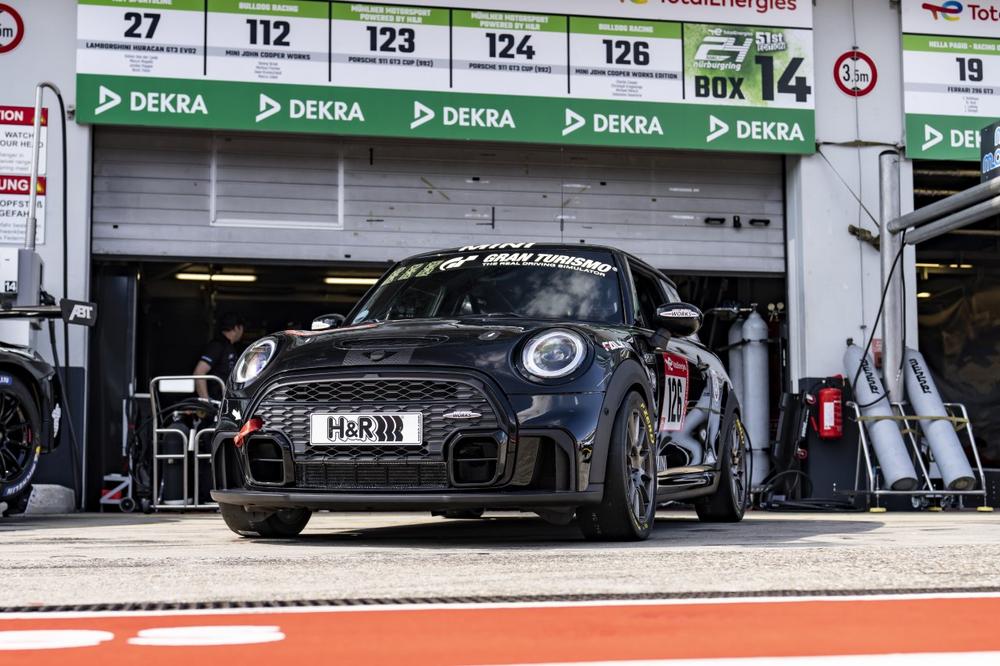Unrest spread through various teams during qualifying, which reached its climax in the third qualifying session. In an inexplicable way, numerous race cars broke down with tyre problems. Always on the left side of the drive axle. Within just 15 minutes, three Porsche 911 GT3s limped into the pits with a puncture on the left rear. The MINI John Cooper Works – in the classic MINI look with red paintwork – in the SP3T racing car class, which had started with high hopes, also suffered several punctures with different wheel and tyre combinations. The damage always occurred on the left front and forced the team to withdraw the car from the race. A bitter setback for last year’s crowd favourite, a tragedy for the team.
The team shook off the disappointment and focused all attention on the second starter, the black MINI John Cooper Works 1to6 Edition with manual 6-speed gearbox and start number #126 in the class of turbocharged close-to-production vehicles with a displacement of 1,600 to 2,000cc. A class in which some significantly more powerful vehicles competed – and so the qualifying result of ninth place out of ten participants seemed sobering at first glance.
But a qualifying session is not a race and a sprint is not a marathon. After the problems in the qualifying sessions, the overall field had been reduced to 131 participants in 20 different classes. This did nothing to dampen the mood among the 235,000 fans. Whoever believes that motorsport is doomed to extinction in times of the mobility revolution should visit the Ring. More than 500 drivers, amateurs and full professionals, 131 starters with a power range from 200 to 600 hp. Number plates from all over Europe in the car parks. Tens of thousands of fans camping and celebrating around the circuit days in advance – whether at the Adenauer Forst, the Brünnchen or Hatzenbach. Motorsport you can touch. 40 percent of the fans are between 14 and 35 years old – a very important advertisement target group.
Enthusiasm for the sport unites them all. Fans, drivers, technicians – and TV viewers: The 24-hour race at the Nürburgring is broadcast live in more than 200 countries, millions of people tune in.
In the Bulldog Racing team, at least, not only the excitement rose, but also the mood. "Even though our race car was finished just the day before qualifying, we were always convinced of its performance and reliability," says Alexander Schabbach, Managing Director of Bulldog Racing.
And so the little miracle took its course. We have already reported on the course of the race in our last newsletter. Quick recap: 2nd place for the MINI John Cooper Works 1to6 Edition in its class, 76th place overall and thus 49 places gained, 114 laps completed, 2,893 kilometres driven, 15 pit stops.
The Ring had a new crowd favourite. And the fans have a good memory. The connection between MINI and Cooper has always put a smile on the faces of the supporters. Many visitors know the history of MINI in motorsport: from small underdog to big hero. Alec Issigonis revolutionised the small car with the classic Mini, his friend John Cooper turned it into a racing car.
When the classic Mini started competing in circuit races and rallies in the early 1960s, it quickly turned the established order on its head. These, too, were initially close-to-production vehicles that quickly enjoyed great popularity as inexpensive racing machines. The circuits suited the classic Mini just as much as the rally tracks. Low weight, excellent handling: a good basis for becoming the king of the bends. The crowning glory of the early years were the three victories in the overall standings of the Monte Carlo Rally in 1964, 1965 and 1967. The classic Mini was so sought-after that numerous racing careers began in a Mini. In 1968, Niki Lauda drove his first hill climb race in a Mini and finished second. Graham Hill, Jackie Stewart, John Surtees, Jochen Rindt and James Hunt also made their first competitive experiences in a classic Mini.
Motorsport has always been a pioneer, a testing and development platform. There is still a strong synergy between motorsport and production cars – regardless of the drive technology. The knowledge and technology transfer from the race track to car production still plays an important role.
"Of course, the situation in the 1960s is not comparable to today," says Alexander Schabbach. "The circumstances have changed and the conditions are too far apart. We won’t beat the 550 hp cars of the GT3 class tomorrow. But we might be able to open a new chapter in the MINI motorsport history in certain racing classes. As they say, anyone who doesn’t believe in miracles is not a realist."
Bulldog Motorsport GmbH
Burgstraße 5a
53520 Nürburg
http://bulldog-racing.com
E-Mail: press@bulldog-racing.com
![]()

